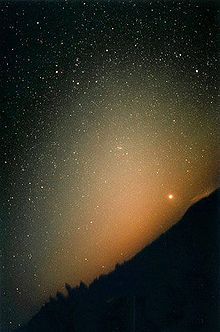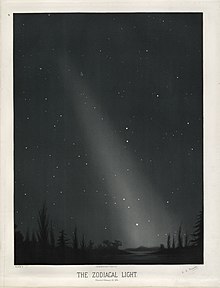Zodiacal light

The zodiacal ( gr. Ζῳδιακός Zodiakos , Zodiac '), also zodiac light called, is a weakly luminous permanent appearance along the ecliptic in the zone of the zodiac . As long as the night sky is not outshone, the astronomical phenomenon can be perceived as a diffuse, wider cone of light close to the horizon. The zodiacal light is created by the reflection and scattering of sunlight on particles of the interplanetary dust and gas cloud, which surrounds the sun as a thin disc in the planetary plane.
The zodiacal light spans the entire sky along the ecliptic. Its area a few degrees around the sun is known as the F-corona . It is followed by the main light of the zodiacal light, decreasing in a wedge shape. This merges into the very faint, narrow light bridge , which leads to the somewhat wider and less brighter counter- light - near the opposite point of the sun . Connecting all around, the weak band-shaped brightening is also called zodiacal (light) band .
observation
On very clear nights, the zodiacal light is diffuse and weakly shining above the horizon as an oblique or steep strip. The main zodiacal light becomes visible in the west around the end of astronomical twilight ; it disappears in the east by being outshone by the beginning of dawn .
The zodiacal light can be observed all year round, provided that there is sufficient distance from artificial light sources and the light pollution they cause . In temperate latitudes , it works best in spring after dusk and in autumn before dawn.
Emergence

The effects of the zodiacal light such as the F-corona, light bridge and counter-light arise through reflection and scattering of the sunlight on dust particles, which surround the sun as a thin disk, in approximately the same plane as the planets. This interplanetary dust is constantly being created by the collision of small rocks such as meteoroids and asteroids .
The density of dust particles from 0.001 to 0.1 mm in size is 10-14 particles per cubic centimeter, corresponding to ten particles per cubic kilometer. Due to the Poynting-Robertson effect , the size of the particles is selected with the effect that particles larger than 0.001 mm are slowed down by the solar radiation, drift in a spiral towards the sun and ultimately evaporate. Smaller particles are only subject to the Poynting-Robertson effect to a limited extent and are driven out of the solar system by the predominant radiation pressure of the sun.
The zodiacal light can be seen particularly well when the sun rises or sets in as steep an angle as possible, which is the case in Central Europe at the beginning of spring and autumn. During this time, the twilight is shortened, and the light rises particularly high above the horizon. In the equatorial latitudes this condition is fulfilled all year round.
The brightness of the zodiacal light is directly related to the angle dependence of the light scattering; With the parameters particle size and density, refractive index and reflectivity , the brightness distribution can be represented well as Mie scatter and classical scatter:
- The forward scattering is very large, as can be seen from the pronounced F-corona and the relatively bright zodiacal light near the sun.
- At a distance of 90 degrees to the sun, the scatter is small, corresponding to a very weakly shining light bridge.
- The backward scattering by 180 degrees increases somewhat, which is why the counter-glow stands out as a light spot.
The surface brightness of the light bridge and the backlight differs only slightly from that of a clear night sky and is between around 150 to 200 S 10 . The brightness distribution in the opposite shining area is not symmetrical to the antisolar point.
history

The Egyptians probably observed this light phenomenon a few thousand years ago. The first detailed description of the zodiacal light was created in the years 1682–1683 by the Italian mathematician and astronomer Giovanni Domenico Cassini and his Swiss colleague Nicolas Fatio de Duillier . However, the phenomenon of zodiacal light was already mentioned in Muslim sources, including the collection of hadiths (sayings of the Prophet Muhammad) by the Islamic scholar Al-Buchari from the 9th century ( Saheeh al-Buchari ). Here the vertically standing appearance of the zodiacal light (as false twilight) is differentiated from the later and horizontally occurring dawn, according to which prayer dates are to be correctly determined.
As far as is known, the counter-glow of the zodiacal light was first observed in 1730 by the French Jesuit priest and professor Esprit Pézenas (1692–1776). Alexander von Humboldt made further observations from 1799–1803 during his trip to South America. The term “counter-certificate” also goes back to him. The Danish astronomer Theodor Brorsen published the first systematic studies of the counter-evidence in 1854 and was already able to interpret it correctly. At the same time, Brorsen was the first to observe that the zodiacal light is a phenomenon that spans the entire sky, which under favorable conditions can be seen as a band with a weak light bridge from the main light to the counter-light, known as the zodiac band. The dust clouds that caused it were finally discovered by the astronomer Walter Grotrian (1890–1954).
See also
- Aurora borealis
- Luminous night cloud
- Afterglow
- dusk
- Counter dawn
- Purple light
- Alpenglow
- Photometeor
- Sky observation
literature
- Stanley F. Dermott et al .: A circumsolar ring of asteroidal dust in resonant lock with the Earth . In: Nature 369, 719 (1994)
- Christoph Leinert, B. Moster: Evidence for dust accumulation just outside the orbit of Venus. In: Astronomy and Astrophysics 472 , 335 (2007)
- Brian May : A Survey of Radial Velocities in the Zodiacal Dust Cloud (Ph.D thesis, Imperial College of London, 2007)
Individual evidence
- ↑ C. Winkler, T. Schmidt-Kaler, W. Schlosser: The plane of symmetry of the zodiacal light and the structure of the counter-light. In: Astronomy and Astrophysics. Volume 143, 1985, p. 200; here online
Web links
- The Gegenenschein - Astronomy Picture of the Day of December 26, 2006 (English).
- Zodiacal Light and False Twilight - Astronomy Picture of the Day of September 25, 2007.
- Zodiacal Light Over New Mexico - Astronomy Picture of the Day, December 14, 2008.
- Zodiacal Light Bridge over Jeßnigk , Sept. 12, 2010 Germany - 11th Herzberg Telescope Meeting

